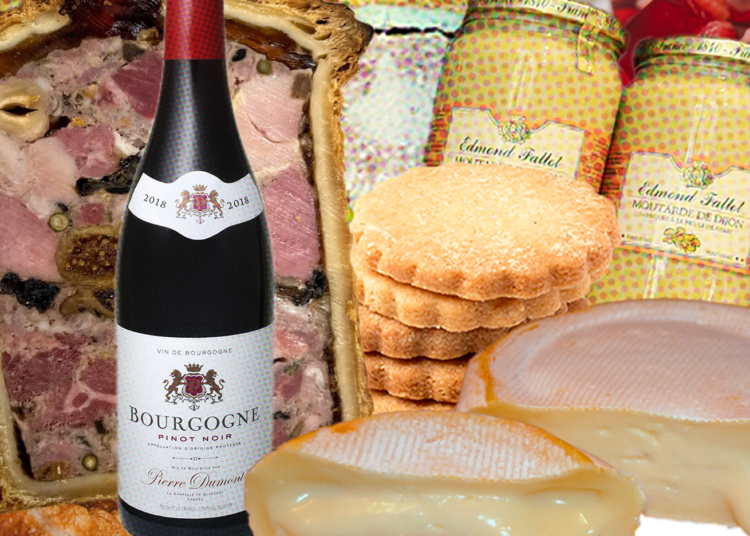There’s no shortage of giftable food items in Paris. | Photo illustration by Marcello Bevilacqua; see below for full credits
Don’t buy your cheese, jam, and wine just anywhere. And don’t just shove it in your suitcase. Follow our expert advice, and you’ll arrive home with the best — and most intact — food souvenirs from Paris
When I travel, shopping for food and tabletop items is a must — spices, sweets, and antiques allow me to savor and relive my experience when I return home. These specific tastes are also how I prefer to share the essence of Paris, my adopted city, with my family back in the States. Once upon a time I’d haul back macarons and Mariage Frères tea, but now they’re sold stateside or are available with the click of a button, so I like to look for tastes of Paris that aren’t as easy to find elsewhere.
Paris has a lot to offer in the way of food souvenirs. Below is a list of items to seek out on your next trip. If you’re short on time, a single trip to La Grande Épicerie, Galeries Lafayette, or even Monoprix for basic items works. However, by heading to these smaller shops, you will have the opportunity to experience the épiceries and institutions that give Paris its charm.
Where to buy pantry staples in Paris
Compagnie Française des Poivres et des Épices
Spices
What to look for:
Choose herbs and spices that will add typical French flavors to your meal and are only available from protected areas, such as salt from the marshes of Guérande in western France or the Camargue in the south. If you buy piment d’espelette from the Basque region, make sure it is marked AOC, appellation d’origine contrôlée, signifying that it is an official pepper from the region and processed under Espelette’s strict standards. (France loves protecting food and wine traditions.)
Where to go:
Compagnie Française des Poivres et des Épices
7 Rue de Furstemberg, 6th arrondissement
A short walk from the Boulevard Saint-Germain will bring you to this charming little spice shop on the Place de Furstemberg. The family-run shop carries several different sugars and dozens of salt and pepper varieties, arranged in little white tin cans and glass cloches to allow you to take in the aromas.
The shop’s Coffret Français gift box, with a blend for traditional chicken and potato roasts, is an ideal souvenir. It also includes salt from the Guérande marshes in the Pays de la Loire region of France, which has been in use for 3,000 years, and herbs de Provence, the iconic aromatic blend of rosemary, oregano, and thyme found all around the south of France. In addition to the coffret, be sure to grab a bottle of piment d’espelette and Peugeot bistro pepper grinders. And if you want something a bit fancier, you can find cast iron, sterling silver, and Lalique crystal grinders.
Tea
What to look for:
Ajiri Aki
Confiture Parisienne.
Tea is ubiquitous; when in France, find a brand that isn’t available where you live, has a wide variety of flavors to choose from, and beautiful packaging for gifting. Mariage Frères, Dammann Frères, Palais des Thés, and Kusmi Tea are all great French brands to seek out.
Where to go:
Méert
16 Rue Elzevir, 3rd arrondissement
Méert is a confectionery and tea shop with old-world charm. The brand was founded in 1677 in Lille and the shop evokes this history, with sweets stacked on antique counters and in bonbon jars and painted tea tins lining the wall. Try the Thé de la Comtesse, a green tea with hints of violets and raspberries, or the Thé des Littéraires, a black Ceylon tea with vanilla, lavender, and bergamot and a painting of Marcel Proust on the front.
Méert is also well known for its gaufres, waffles filled with caramel beurre salé, and its signature Madagascar vanilla. But don’t overlook the boxes of caramels or meringue-filled tin cans, which travel well and have a long shelf life.
Confiture
What to look for:
Confiture (preserved fruit) brands like Bonne Maman are available all over the world, so it’s better to seek out something artisanal, like Confiture Parisienne, Alain Milliat, and L’Épicurien. These brands usually use unrefined cane sugar and avoid additives and preservatives.
Where to go:
Confiture Parisienne
17 Avenue Daumesnil, 12th arrondissement
This store and workshop is located in the arcades of the Viaduc des Arts, a converted train line that hosts a string of workshops and artisan ateliers. In the shop, you sample from 90 flavors of jams and jellies, while watching the team mix them in giant copper containers behind glass.
The shop’s confiture fraise tomate (strawberry tomato) is a standout. But you also can’t go wrong with varieties like carrot passion fruit vanilla, la confiture de la Tour Eiffel (strawberry and rosemary), orange grapefruit clementine kumquat, or the blanc de blancs Champagne jelly or rosé jelly. And be sure to test out the savory jams for your aperitif hour, such as the chutney d’oignon rose, cornichon chutney, and poivron cetterave chutney.
How to get it home:
Confitures are sold in glass jars so put them in a plastic resealable bag and place it snugly in some clothes in your checked luggage.
French mustard
Ajiri Aki
G. Detou.
What to look for:
If you remember the mustard shortage of 2022 and the mad rationing that followed, then you will understand how integral this condiment is to French cuisine. It’s used in tarts, vinaigrettes, and sauces, and served with steak. Most French mustard producers use Canadian-grown seeds, so for a special souvenir, target mustard that is grown and made in France.
Look out for Moutarde de Meaux Pommery (varieties include flavorings like honey, green peppercorn, gingerbread, truffle, and cognac) or Martin-Pouret (piment d’espelette, Indian spices, bearnaise, honey, and chardonnay). My personal favorite is Edmond Fallot, which has been producing artisanal mustards since 1840 in Beaune, near Dijon, with seeds grown in the region: Its tarragon mustard feels particularly special, but the cassis, green peppercorn, basil, walnut, the classic Dijon, and white wine flavors are all worth trying.
Where to go:
G. Detou
58 Rue Tiquetonne, 2nd arrondissement
G. Detou is highly regarded among bakers and chefs. There are two stores adjacent to one another, one focused on sweets and the other on savory goods. While you’re there, you can also grab some vinegars from Martin-Pouret, honey from Le Rucher de l’École, and cacao from Valrhona.
How to get it home:
Mustards are sold in glass jars or ceramic pots so wrap cloth around each jar, and put them into checked luggage.
Creme de marron
What to look for:
Creme de marron, or chestnut cream, has a roasted, nutty, toffee taste and is a staple in many French pantries. There are a variety of brands, but one by a celebrated pastry chef is guaranteed to be delicious on your own confections.
Where to get it:
Sébastien Gaudard
1 rue des Pyramides, 1st arrondissement
Located near the Tuileries, Sébastien Gaudard is a charming pastry and tea room with a vintage aesthetic inside and cafe vibes with chairs and tables outside. Be sure to try the tea, confiture, and honey too.
How to get it home:
Creme de marron comes in glass bottles and usually has a shelf life of up to three years. Wrap it in your socks or a T-shirt and put it into your checked luggage.
Where to buy chocolate, sweets, and treats in Paris
Philippe Vaurès Santamaria/Poilâne
Outside Poilâne.
Butter biscuits
What to look for:
Pur beurre (translation: pure butter) and sables Bretons are classic French biscuits. The former are similar to shortbread and are made with unsalted butter, while the latter, from Brittany, use salt as well as butter. They’re both delicious.
Where to go:
Poilâne
8 rue du Cherche-Midi, 6th arrondissement
Poilâne, founded in 1932, knows how to work flour, eggs, and sugar. This is the original location, with a cafe and bakery side by side. While there are other types of biscuits on offer, the Punitions biscuits are trademarked for good reason. They’re made without additives, preservatives, or coloring agents — just eggs, butter, flour, and sugar, baked over a wood fire.
How to get it home:
The biscuits are often sold in a box and occasionally you can find them in a tin, making them easy to transport without turning into a bag of crumbs.
Poilâne
Poilâne’s Punitions biscuits.
Chocolate
What to look for:
There is no shortage of chocolate shops in Paris, and many chocolate formats to choose from: You can find delicious chocolate from celebrated names like Alain Ducasse, Pierre Hermé, Jacques Génin, Cyril Lignac, and Pierre Marcolini at namesake shops across the city. Most shops will happily offer a sample and answer your questions, but a box of assorted chocolates is always the best way to enjoy different varieties.
Where to get it:
À La Mere de Famille, various locations
À La Mère de Famille is the oldest confectionery in Paris, with 10 locations across the city. The Belle Epoque location on Rue du Faubourg Montmartre in the 9th has been listed as a historic monument, and its interior boasts old-world charm with antique floor tiles and wooden counters lined with glass bonbon jars.
Its caramel beurre salé chocolates are a smooth blend of two sweets. While you’re stocking up on sweets, try the nougat, pure butter biscuits, florentines, mendiants, and chocolate-covered almonds. If deciding on one chocolate is too difficult, go for an assortment in a keepsake tin.
Wine and spirits
What to look for:
At small caves à vin, owners and their teams are there to help you find the perfect wine. Be ready with your preferences for white or red, light or full bodied, a bottle for an aperitif or to drink with dinner, and so on.
Where to go:
La Cave de Belleville
51 Rue de Belleville, 19th arrondissement
La Cave de Belleville is a wine bar and cellar in the 19th arrondissement in Belleville. There are long tables down the center of the space where you can enjoy wine with plates of charcuterie and cheese. If you aren’t in a hurry, spend some time enjoying a few wines, then purchase your favorite one to bring home. The shop is organized by region, with several experts ready to guide your nose and palate. If spirits are more your thing, Maison du Whisky at Odéon specializes in whiskey and spirits from France and around the world.
How to get it home:
Most wine shops have boxes and bubble wrap on hand. If you only purchase one bottle, then surrounding it with bubble wrap and clothes in your checked luggage works fine. For two or more bottles, bubble wrap works, but consider a box or bottle separators.
Cheese, charcuterie, and tins
Cheese and cured meats
Ajiri Aki
Some of the selection at Maison Plisson.
What to look for:
It can be useful to ask about a shop’s most popular products to find out where it excels — or for what products it may have won awards. For cheese, you should always ask what is in season, and if you are traveling internationally, stick to hard or semi-soft cheese. Note that the store clerk won’t reliably know what you’ll be permitted to travel with.
Where to go:
Maison Plisson
93 Boulevard Beaumarchais, 3rd arrondissement
Maison Plisson in the Marais is part grocery store, part cafe-restaurant on a busy boulevard between Bastille and Republique. It only sells the best products from smaller and underrepresented producers across France. The Prince de Paris is a traditional Parisian ham with no antibiotics, nitrates, or artificial ingredients; it’s also the only style of ham made in Paris. For cheeses that’ll travel well, try the Comté, Camembert, Beaufort, Gruyere, or Emmentaler.
How to get it home:
Almost every épicerie will vacuum pack your meat or cheese which can then be stored in your checked luggage, and as it’s quite cold in the luggage area underneath the airplane, that’s a perfect place for it. (Maison Plisson advises that meat and cheese in sous vide packaging is fine for up to eight hours outside of a refrigerator.) However, it’s important to note that certain foods, including some cured meats and unpasteurized cheese, are not allowed into the U.S. and may only be able to be enjoyed if you’re traveling to another destination in the E.U.
Foie gras
What to look for:
Foie gras can be controversial, but if this French delicacy doesn’t offend, you will find it available at almost every gourmet food store. Look for brands from Dordogne and Les Landes, and stick to cans and jars as opposed to refrigerated sous vide blocks.
Foie gras is meant to be cut from a block (like cheese) and eaten on toast. Try it with onion or rhubarb chutneys to enhance the flavors.
Where to go:
Lafitte
47 rue Cler, 7th arrondissement
Lafitte is a modern shop lined with only two walls of jars and cans of meat. It’s a futuristic, zero-fuss contrast to most historic brands, but it’s been selling canned meats since 1920. It also has a large variety of rillettes, pates, and spreads.
How to get it home:
Canned foie gras, pate, and duck confit are allowed into the U.S. as long as they are in a can or jar with the manufacturer ingredients clearly listed.
Canned seafood
What to look for:
Canned or jarred seafood is popular in France, in part because of the seafood culture from Normandy and Brittany. Check the packaging to see where exactly the fish is from to make sure you are buying something from the coasts of France (and not Portugal or Spain). In addition to plain tuna, sardines, and mackerel, try varieties that are mixed with lemon, tomatoes, or spices.
Where to get it:
La Belle-Iloise, various locations
La Belle-Iloise was founded in 1932 and sells canned tunas, sardines, mackerel, and soups from Quiberon, Brittany. You’ll find the brand in many épiceries in Paris, but it also has its own shops with five locations across Paris. The shop at 53 Rue Montorgueil in the 2nd arrondissement has the added bonus of being on a picturesque pedestrian street full of other food shops, restaurants, and cafes.
These products make great gifts, especially in boxed sets with charming packaging. The shops also sell jarred seaweed mayonnaise, hummus, seaweed spreads, and everything else you need to host seafaring aperitif hours back home.
How to get it home:
Canned seafood is allowed in the U.S., but should be stored in your checked luggage because of the oil or liquids some cans contain may exceed airline limits.
Home goods and cooking tools
Pierre Prospero/Landline
Landline.
Vintage tableware
What to look for:
The French are known for their “art de la table,” and you’ll find various types of metal and porcelain tableware ranging from the 18th to mid-20th centuries. Ask a sales associate if you are looking for a specific pattern or brand like Christofle or Gien. However, many small manufacturers copied the big expensive houses, so you’ll find equally beautiful no-name items from houses no longer in existence. Look closely for cracks in glass or porcelain and any rust on metal items that is hard to remove. However, part of the beauty of antique treasures is in their faults.
Use your imagination when shopping for vintage tabletop pieces. Many have multiple uses beyond their original purpose. A Champagne bucket can also be a flower vase, a misshapen cutting board can be wall art, and a crystal sugar bowl can also hold your jewelry.
Where to go:
AXS Design
12 rue St Sabin, 11th arrondissement
AXS is an antique shop tucked away in a seemingly private cobblestone courtyard in the 11th arrondissement. The shop has two rooms full of silver-plated cutlery in jars, stacks of ceramic plates on shelves and tables, beveled crystal glassware, folded red and ecru torchons (hard linen kitchen towels), and embroidered tablecloths on hangers.
How to get it home:
Silver cutlery can easily be wrapped in tissue paper but the breakables need more care. It’s best to wrap porcelain plates individually, then together in sets of two or four with a piece of cardboard in between each plate. Fill all hollow spaces in items such as glassware, vases, and soup tureens with brown packing paper before wrapping fully in bubble wrap. To ensure your treasures make it home safely, take them in your carry-on luggage. If you get carried away and buy more than airlines will allow, AXS offers shipping services.
Ajiri Aki
AXS.
Cookbooks
What to look for:
If you can read French (or use a translation app), then a cookbook is the best way to master tarts, soufflés, and recettes de grand-mere. Keep an eye out for Hachette, a major publisher with cookbooks tackling just about every French culinary topic and ingredient. Not all French language cookbooks are widely available, so visiting a cookbook store as opposed to a general bookstore will give you a bigger selection. Plus, Paris loves themed bookstores.
Where to go:
The Librairie Gourmande
92-96 rue Montmartre, 2nd arrondissement
The single-floor Librairie Gourmande is not the fanciest of bookstores, but it’s centrally located and stocks a large collection of French language books devoted to food. Alternatively, book collectors and lovers of food history and art de la table can take a stroll to visit the bouquinistes that have been installed along the quays of the Seine since the 16th century. On the Quai Conti across from the Hôtel des Monnaies you will find a seller that specializes in food literature, vintage cookbooks, and Larousse encyclopedia posters.
French kitchen supplies
What to look for:
Aspiring chefs often make pilgrimages to France to attend its famed cooking schools, leaving with tools of the trade used by many Michelin-starred restaurants. Ask sales associates for the stories behind brands, which are often small family-run businesses with decades of history.
Where to go:
Landline
107 Avenue Parmentier, 11th arrondissement
Landline is a concept store in the 11th with floor-to-ceiling shelves full of ethically sourced tabletop items, kitchen tools, toys, and paper goods from small companies. Shop for colorful, hand-painted ceramics from Dimanche Vaisselle and Samantha Kerdine, oven mitts made from deadstock fabric, traditional Sarreguemines white porcelain ramekins, and surprisingly useful kitchen tools, like tomato knives, zigzag wine openers, heated ice cream scoopers, and brass pepper mills.
How to get it home:
Metal kitchen tools can easily be packed in your carry-on or checked luggage. (Don’t put any of the sharper items in your carry-on or they may be confiscated.) Porcelain items should be wrapped in bubble wrap or tissue paper and kept in a carry-on.
Copper pots
What to look for:
Copper pots are an extremely efficient way to evenly spread heat when you cook — not to mention they’re the prettiest cookware to display in a kitchen.
Mauviel 1830 copper pots are the Rolls-Royce of copper cookware, with the price tag to match. It’s best to pick a few pieces on each visit and slowly amass a collection over time. The centuries-old company is well known for its quality and traditional manufacturing techniques, so your pots will likely outlive you. Be sure to ask for a tub of copper cleaner as well; the beauty of copper pots requires a lot of maintenance.
Where to go:
E. Dehillerin
18-20 Rue Coquillière, 1st arrondissement
Ajiri Aki
E. Dehillerin.
E. Dehillerin has long been an institution for home cooks and chefs, including Julia Child. It’s a treasure trove of supplies, but the narrow aisles and messy layout are part of its charm.
How to get it home:
Depending on the size of the pots you purchase, you might consider buying an additional suitcase to transport them or mailing a box of your goods home to lighten your load.
A little bit of everything
A boxed set of Parisian flavors
What to look for:
The best boxed gift sets feature products made in Paris and highlight iconic French flavors and ingredients. Some stores and restaurants will put together their bestsellers, and others might give you a pretty box and allow you to assemble your favorites yourself.
Where to go:
La Tour d’Argent
15 Quai de la Tournelle, 5th arrondissement
La Tour d’Argent, founded in 1582, is the oldest restaurant in Paris. The associated épicerie is on the ground floor of the iconic restaurant, which boasts one Paris’s best views (and commands the highest price to match).
The shop’s Le Coffret Emblématique gift box offers a taste of what the restaurant is known for, including good wine and duck. If the box is a bit overwhelming you can also purchase honey, tea, sweets, or wine from the épicerie.
You’ll also find memorable boxed gift sets at Maison Plisson, Fauchon, La Maison du Caviar, Ladurée, and Maxim’s.
Ajiri Aki is the author of JOIE: A Parisian’s Guide to Celebrating the Good Life and the founder of Madame de la Maison, an antique e-commerce shop.
Additional photo credits: Mustard photo by Ajiri Aki; terrine photo by Ajiri Aki; biscuits by Poilâne; bottle of wine by Olga Popova/Shutterstock; cheese by Nat Belkov














